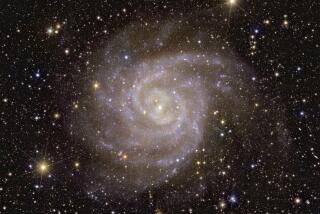An Ultimate Map to the Stars’ Home
- Share via
In an era of stunning new maps--of the canyons of Mars, the rugged terrain of the ocean bottom and the intricate human genome--an international team of astronomers is undertaking the most ambitious map-making project yet: They are surveying the sky.
Tuesday, scientists released the first major results from the $80-million Sloan Digital Sky Survey. They include the discovery of the two most distant objects ever seen, more glimpses of the frothy network of galaxies that makes up the universe and, closer to home, a catalog of asteroids with the potential to one day hit Earth.
Scientists also released the first few pages of their new celestial gazetteer, 5% of an immense map that will eventually contain 30 trillion bytes--more information than the Library of Congress--with information on 200 million of the galaxies, quasars and celestial exotics that make up the universe.
“This will literally be the field guide to the heavens,” said Mike Turner, a cosmologist at the University of Chicago who also serves as a spokesman for the project. The project, he predicted, will help scientists understand “the wondrous panoply of structure we see in the universe today.”
The five-year project will eventually create high-resolution, five-color images of one-quarter of the entire sky. The information will be used to create a three-dimensional map of the universe that astronomers hope will reveal basic structures that will allow them to explain how the universe evolved.
Already, the new images and data, released at the American Astronomical Society meeting in Pasadena, were being celebrated by scientists.
“I’m wowed by it all,” said Anneila Sargent, an astrophysicist at Caltech who serves as president of the American Astronomical Society. “I think it will turn a great many astronomical theories on their heads.”
The survey, scientists announced, already has detected the two most distant celestial objects ever observed. They are quasars, extremely bright but compact objects fueled by black holes that burn with the fire of a billion suns.
The farthest object is an estimated 80 billion light years from Earth. (A light year is 6 trillion miles, the distance light can travel in a vacuum in one year.) Although the universe is thought to be only 10 billion to 20 billion years old, objects can be more than 20 billion light years away because the universe is expanding.
The previous long-distance record holder, discovered by the Sloan survey last year, was a quasar 26 billion light years away.
Scientists are not hunting the quasars simply to find the universe’s oldest objects; they hope to use the quasars that formed when the universe was a mere infant to determine what came afterward.
“We know the universe started out very smooth,” said Donald Schneider, a survey member from Pennsylvania State University. “We have to figure out how it got so lumpy. The most distant objects are important signposts.”
The bright light of quasars can be used to illuminate the many objects that are closer to Earth and help clarify the still murky understanding of the universe’s adolescence and middle-age. “We’re trying to illuminate the Dark Ages,” said Schneider.
Other results will also help scientists understand the deeper structure of the universe. Astronomers already know that galaxies cluster in sheets and filaments that surround vast stretches of empty space like soap bubbles, but they do not agree about precisely why. Galaxies gathered in dense clumps are more likely to be older, elliptical galaxies rather than the younger, spiral galaxies that are generally spaced farther apart.
The Sloan survey could help answer the “nature or nurture” question about galaxies, said Alex Szalay, a survey member from Johns Hopkins University. “Did elliptical galaxies form differently?” he asked. “Or is each galaxy born equal and then evolves differently?”
Szalay is also hoping his survey will help cosmologists with their most nagging scientific mystery: How much invisible dark matter makes up the universe and where is it all hiding? Dark matter is likely made up of exotic structures or particles that have not been detected but are inferred by their gravitational effects on our galaxy.
Much closer to Earth, the survey has confirmed that the asteroid belt between Mars and Jupiter is made up of an inner belt of rocky asteroids and an outer belt of carbon-containing asteroids. That segregation suggests the migration of objects thought to be common in solar systems may not have occurred in our more stable neighborhood, said Tom Quinn, a survey member from the University of Washington.
The Sloan survey images are taken by an 8.2-foot telescope on Apache Point in New Mexico, and findings are followed up with an adjacent 11.5-foot telescope. The project is a private-public international collaboration, with funds coming from the Alfred E. Sloan Foundation, the National Science Foundation, the National Aeronautics and Space Administration, the Department of Energy, the governments of Japan and Germany, and a consortium of universities.
Images and information about the project are available at https://www.sdss.org.






